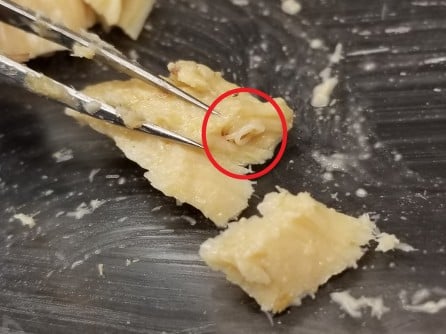Alaska’s waters are a vital fishery for salmon, and the complex marine food webs that support this fishery are of great interest to scientists studying the impact of climate change. However, finding samples from the past to study these food webs is a challenge. Natalie Mastick, a postdoctoral researcher at the Peabody Museum of Natural History at Yale University, found an unconventional solution: old cans of salmon.
Mastick and her colleagues at the University of Washington in Seattle examined 178 cans of salmon fillets from four species, caught over a 42-year period in the Gulf of Alaska and Bristol Bay. They dissected the preserved fillets and counted the number of anisakid roundworms, a common marine parasite, within the flesh. These parasites, killed during the canning process, pose no danger to humans if consumed.
“Everyone assumes that worms in your salmon is a sign that things have gone awry,” said Chelsea Wood, a UW associate professor of aquatic and fishery sciences. “But the anisakid life cycle integrates many components of the food web. I see their presence as a signal that the fish on your plate came from a healthy ecosystem.”
The research team found that anisakid worm levels increased for chum and pink salmon from 1979 to 2021, while remaining stable for coho and sockeye salmon. Anisakids have a complex life cycle, requiring various hosts such as small marine invertebrates, fish, and ultimately marine mammals, where they reproduce. The eggs are then excreted back into the ocean to begin the cycle anew.
“Seeing their numbers rise over time, as we did with pink and chum salmon, indicates that these parasites were able to find all the right hosts and reproduce. That could indicate a stable or recovering ecosystem, with enough of the right hosts for anisakids,” explained Mastick, the lead author of the paper published in Ecology & Evolution.
Several factors could explain the rise in anisakid levels in pink and chum salmon, including the recovery of marine mammal populations following the Marine Mammal Protection Act of 1972, warming temperatures, or the positive impacts of the Clean Water Act. The stable anisakid levels in coho and sockeye salmon are more challenging to interpret, as there are many anisakid species, each with its own series of hosts.
The canning process destroyed the softer parts of the worms’ anatomy, preventing the identification of individual species. However, Mastick and Wood believe this approach could be applied to other canned fish, such as sardines, to gain insights into past ecosystems.
“This study came about because people heard about our research through the grapevine,” said Wood. “We can only get these insights into ecosystems of the past by networking and making the connections to discover untapped sources of historical data.”
The research was funded by the U.S. National Science Foundation, the Alfred P. Sloan Foundation, the Washington Research Foundation, and the University of Washington. Co-authors on the paper include UW undergraduate Aspen Katla, and Bruce Odegaard and Virginia Ng from the Seafood Products Association, a Seattle-based trade group that donated the cans of salmon to the research team.
This innovative study demonstrates the importance of thinking creatively when searching for data sources to understand the impact of climate change on marine ecosystems. By examining parasites in canned salmon, researchers have gained valuable insights into the health of Alaska’s marine food webs over time, paving the way for future studies using similar unconventional methods.


